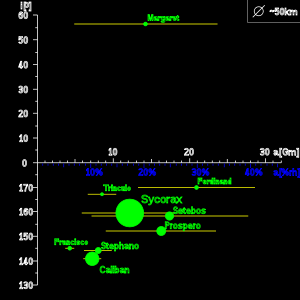.gif)
Margaret (moon)
Encyclopedia
Margaret is the only prograde irregular satellite
of Uranus
. It was discovered by Scott S. Sheppard
, et al. in 2003 and given the provisional designation S/2003 U 3.
Confirmed as Uranus XXIII, it was named after the servant of Hero in William Shakespeare
's play Much Ado About Nothing
.
 Margaret stands out as the only prograde irregular satellite of Uranus. The diagram illustrates the orbital parameters of Margaret, unique among the irregular satellite
Margaret stands out as the only prograde irregular satellite of Uranus. The diagram illustrates the orbital parameters of Margaret, unique among the irregular satellite
s of Uranus, with inclination
on the vertical axis and the eccentricity
of the orbits represented by the segments extending from the pericentre
to the apocentre
.
Margaret's inclination of 57° is close to the limit of stability. The intermediate inclinations 60 < i < 140 are devoid of known moons due to the Kozai instability
. In this instability region, solar perturbations
at apoapse cause the moons in this region to acquire large eccentricities that lead to collisions or ejection over 10 million to a billion years. Margaret's periapsis precession period (Pw) is almost 1.6 million years long.
In 2008, Margaret's current eccentricity was 0.7979. This temporarily gives Margaret the most eccentric orbit of any moon in the solar system, though Nereid
's mean eccentricity is greater.
Irregular satellite
In astronomy, an irregular moon is a natural satellite following a distant, inclined, and often eccentric and retrograde orbit. They are believed to have been captured by their parent planet, unlike regular satellites, which form in situ....
of Uranus
Uranus
Uranus is the seventh planet from the Sun. It has the third-largest planetary radius and fourth-largest planetary mass in the Solar System. It is named after the ancient Greek deity of the sky Uranus , the father of Cronus and grandfather of Zeus...
. It was discovered by Scott S. Sheppard
Scott S. Sheppard
Scott S. Sheppard is an astronomer in the Department of Terrestrial Magnetism at the Carnegie Institution for Science. Starting as a graduate student at the Institute for Astronomy at the University of Hawaii, he was credited with the discovery of many small moons of Jupiter, Saturn, Uranus, and...
, et al. in 2003 and given the provisional designation S/2003 U 3.
Confirmed as Uranus XXIII, it was named after the servant of Hero in William Shakespeare
William Shakespeare
William Shakespeare was an English poet and playwright, widely regarded as the greatest writer in the English language and the world's pre-eminent dramatist. He is often called England's national poet and the "Bard of Avon"...
's play Much Ado About Nothing
Much Ado About Nothing
Much Ado About Nothing is a comedy written by William Shakespeare about two pairs of lovers, Benedick and Beatrice, and Claudio and Hero....
.
Orbit

Irregular satellite
In astronomy, an irregular moon is a natural satellite following a distant, inclined, and often eccentric and retrograde orbit. They are believed to have been captured by their parent planet, unlike regular satellites, which form in situ....
s of Uranus, with inclination
Inclination
Inclination in general is the angle between a reference plane and another plane or axis of direction.-Orbits:The inclination is one of the six orbital parameters describing the shape and orientation of a celestial orbit...
on the vertical axis and the eccentricity
Orbital eccentricity
The orbital eccentricity of an astronomical body is the amount by which its orbit deviates from a perfect circle, where 0 is perfectly circular, and 1.0 is a parabola, and no longer a closed orbit...
of the orbits represented by the segments extending from the pericentre
Apsis
An apsis , plural apsides , is the point of greatest or least distance of a body from one of the foci of its elliptical orbit. In modern celestial mechanics this focus is also the center of attraction, which is usually the center of mass of the system...
to the apocentre
Apsis
An apsis , plural apsides , is the point of greatest or least distance of a body from one of the foci of its elliptical orbit. In modern celestial mechanics this focus is also the center of attraction, which is usually the center of mass of the system...
.
Margaret's inclination of 57° is close to the limit of stability. The intermediate inclinations 60 < i < 140 are devoid of known moons due to the Kozai instability
Kozai mechanism
In celestial mechanics, the Kozai mechanism, or the Lidov-Kozai mechanism, causes a periodic exchange between the inclination and eccentricity of an orbit...
. In this instability region, solar perturbations
Perturbation (astronomy)
Perturbation is a term used in astronomy in connection with descriptions of the complex motion of a massive body which is subject to appreciable gravitational effects from more than one other massive body....
at apoapse cause the moons in this region to acquire large eccentricities that lead to collisions or ejection over 10 million to a billion years. Margaret's periapsis precession period (Pw) is almost 1.6 million years long.
In 2008, Margaret's current eccentricity was 0.7979. This temporarily gives Margaret the most eccentric orbit of any moon in the solar system, though Nereid
Nereid (moon)
Nereid , also known as Neptune II, is the third-largest moon of Neptune. It has a highly eccentric orbit. Nereid was discovered by Gerard Kuiper in 1949 and was the second moon of Neptune to be discovered.- Discovery and naming :...
's mean eccentricity is greater.
External links
- Margaret Profile by NASA's Solar System Exploration
- David Jewitt pages
- Uranus' Known Satellites (by Scott S. SheppardScott S. SheppardScott S. Sheppard is an astronomer in the Department of Terrestrial Magnetism at the Carnegie Institution for Science. Starting as a graduate student at the Institute for Astronomy at the University of Hawaii, he was credited with the discovery of many small moons of Jupiter, Saturn, Uranus, and...
) - Ephemeris IAU-NSES

